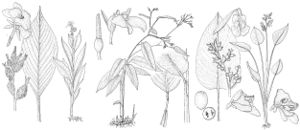Marantaceae
in Engler & Prantl,
Herbs, perennial, from rhizomes. Aerial stems branched or unbranched. Leaves in a basal cluster, both basal and cauline, [or strictly cauline], alternate, differentiated into basal sheath, petiole (occasionally absent), and blade; sheaths often overlapping, supporting stem, open, ligule absent; summit of petiole distinctly differentiated as pulvinus (i.e., region of specialized cells controlling leaf movement, differing in color, often size, from petiole); blade with lateral veins parallel, diverging from prominent midrib. Inflorescences 1–several per aerial shoot, terminal or terminal and lateral on aerial stem [occasionally arising directly from rhizome], scapose or pedunculate [subsessile], compound, headlike or spikelike to diffuse or much branched, bracteate; each bract enclosing pair of flowers or cincinnus of paired flowers [solitary flowers (Monotagma, Monophrynium)]. Flowers bisexual, asymmetric, paired flowers mirror images of each other; sepals and petals differentiated, sepals 3, distinct [rarely connate basally (Megaphyrnium)], petals 3, corolla, staminodes, and style fused basally into tube; fertile stamens 1, occasionally petal-like; anthers 1-locular; staminodes [2–]3–4, outer staminodes [0–]1–2, petal-like, inner staminodes 2, one fleshy (callose staminode), one hooded (cucullate staminode), bearing 1(2 in Thalia) appendage(s), subterminal or medial, fingerlike or flaplike; ovary inferior, 3-carpellate, 3-locular, 1[–3] locule(s) fertile; placentation basal; ovules 1 per locule; terminal portion of style and stigma enclosed in cucullate staminode, explosively released, stout (appendaged in Thalia); stigma cup-shaped. Fruits fleshy [dry] capsules (rarely indehiscent) [berry or achene]; sepals often persistent in fruit. Seeds: aril present [rarely absent]; endosperm scanty or absent; perisperm copious; embryo curved.
Distribution
Lowland tropics of Asia and Africa, mainly (80%) in American tropics, occasionally subtropics, s United States to n Argentina.
Discussion
Maranta arundinacea, and Thalia dealbata, and T. geniculata are cultivated. Marantaceae are clearly monophyletic, uniquely defined by two vegetative traits: leaf venation of broadly sigmoidally-curved (S-shaped) lateral veins with numerous, regular, parallel cross veinlets (attached at right angles) between them and the pulvinus at the base of the leaf blade. The family can be recognized worldwide from a single leaf. Florally, Marantaceae are characterized by their highly modified staminodes and unusual pollination mechanism: explosive, secondary pollen presentation. During the bud stage, pollen is shed onto the back of the style, behind the stigma. At anthesis the style is under tension and is enfolded and held in place by the cucullate (hooded) staminode. Bees, probing for nectar in the flower, depress the appendage (trigger) of the cucullate staminode. This releases the style, which springs forward, moving in a single plane or helically, bringing the cup-shaped stigma in contact with pollen on the pollinator and, in the same motion, depositing fresh pollen on the same spot. Marantaceae are self-compatible but are mainly allogamous (out-crossing). In spite of the elaborate pollination system, some 8% of the species are known to be autogamous (self-pollinating), including all three species in the flora [very rarely cleistogamous]. Such self-pollen is deposited in the stigma during pollen transfer within the bud prior to anthesis, not during subsequent stylar movement.
Within the Zingiberales, Marantaceae are most closely related to Cannaceae, with in which it had been merged untithey were originally placed.l K. Koch (1857) recognized the taxon as a distinct family. The two families share similar leaf venation, presence of specialized cells at the base of the leaf (only a few cells abaxially in Cannaceae, not organized into a pulvinus), and secondary pollen presentation.
The leaves of the three North American species of Marantaceae are all homotropic (all leaves rolled in the same direction in the bud), though extraterritorial species may be antitropic (leaves on opposite sides of the stem rolled in opposite directions, half of the leaves with the left side of the blade larger than the right, opposite leaves with the right side of the blade larger). A prophyll is associated with each pair of flowers in the inflorescence. The North American species lack secondary bracts and bracteoles, although extraterritorial species may have a secondary bract and as many as four bracteoles, which may be modified as extrafloral nectaries. The perisperm of the seed has 1–2 canals.
The family is best known in horticulture for its elaborately patterned leaves, present in 20% of the species (H. Kennedy 1992). Such patterned-leaved species are popular as house plants, especially the ubiquitous Maranta leuconeura, in conservatories, and as ornamentals in tropical gardening. The most significant food plant is Maranta arundinacea, cultivated in tropical regions worldwide for arrowroot starch.
Genera 31, species ca. 530 (2 genera, 3 species in the flora).
